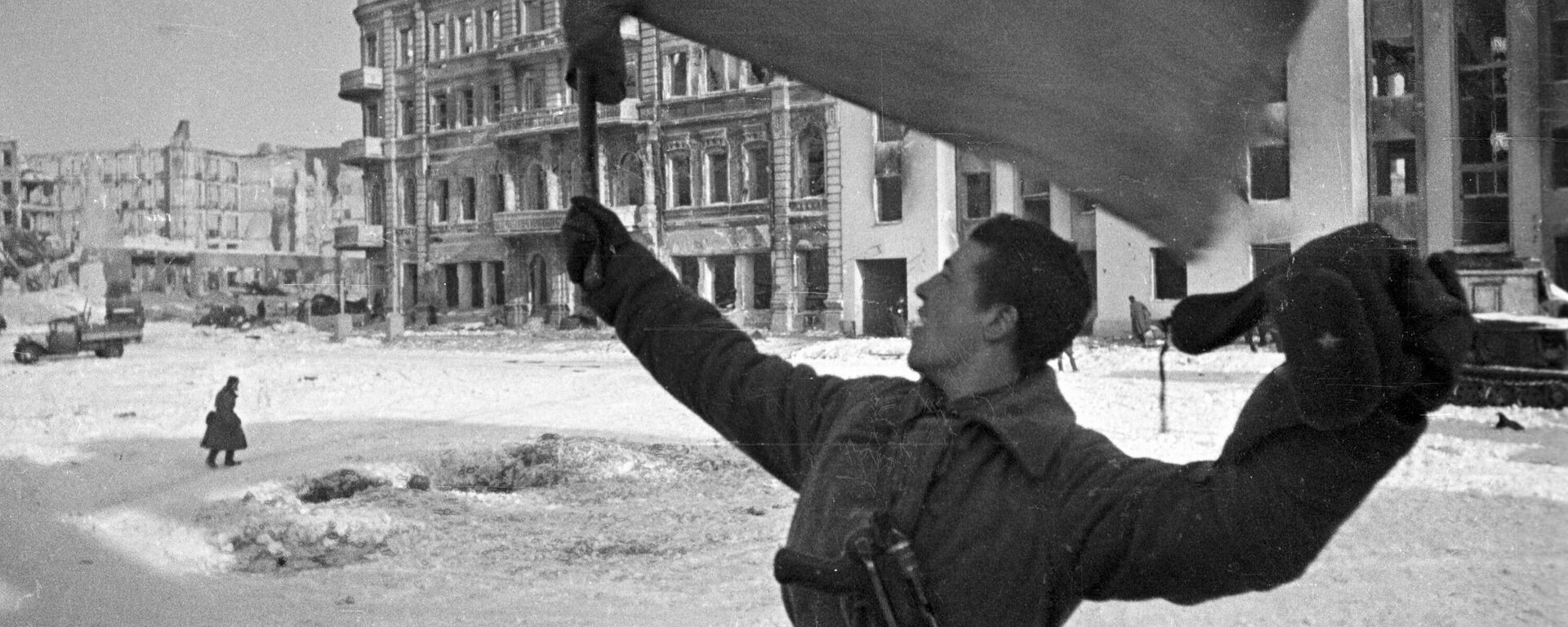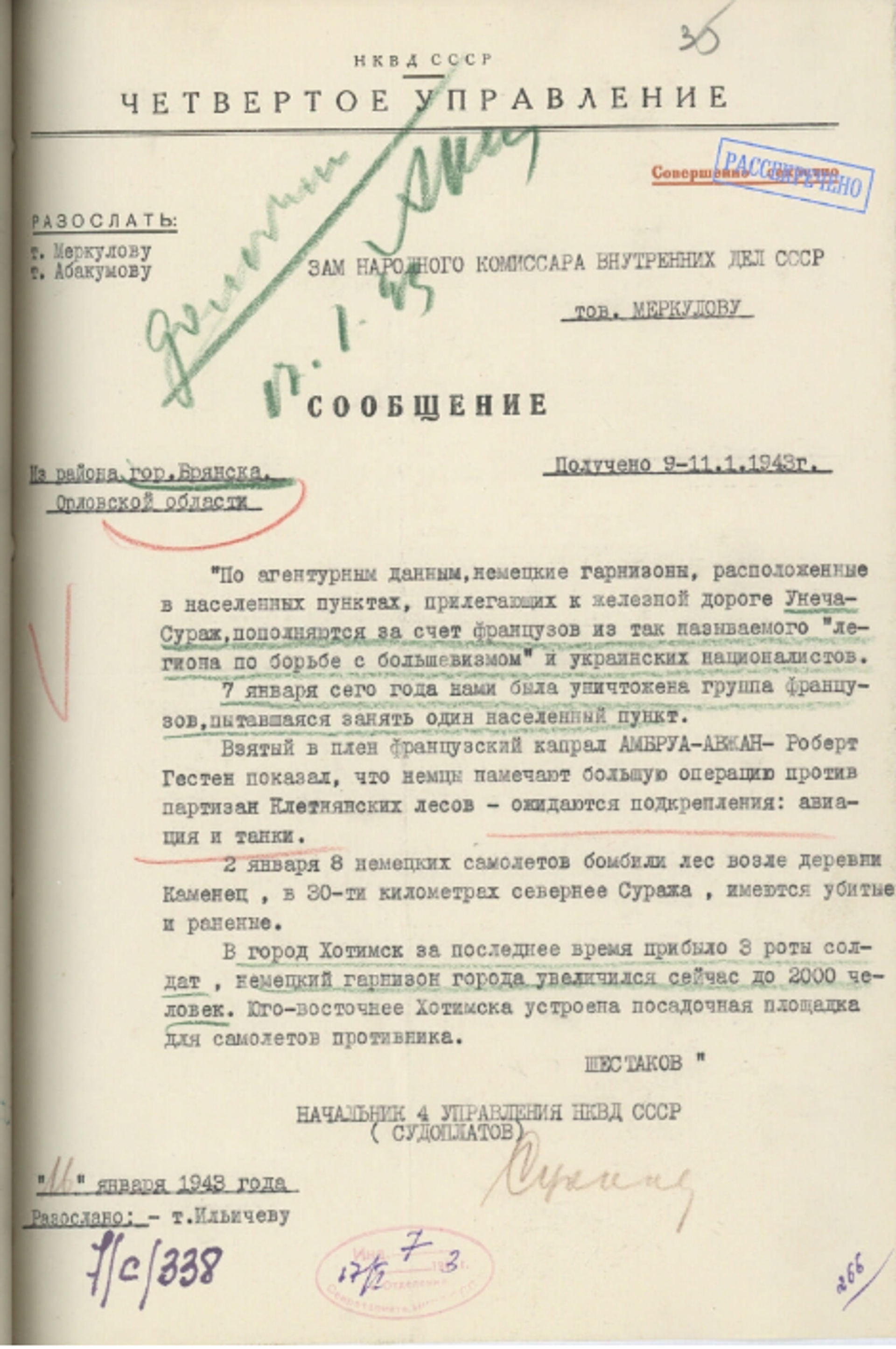https://sputnikglobe.com/20240412/unearthed-doc-reveals-french-fascist-forces-collaboration-with-ukrainian-nationalists-during-wwii-1117897830.html
Unearthed Doc Reveals French Fascist Forces’ Collaboration With Ukrainian Nationalists During WWII
Unearthed Doc Reveals French Fascist Forces’ Collaboration With Ukrainian Nationalists During WWII
Sputnik International
Russia and France have not fought one another since the Patriotic War of 1812, and were allies during both the First and Second World Wars. However, the fight of French fascist forces allied to Hitler against the USSR during WWII is a well-documented fact, even if it’s often unjustly relegated to the status of a historical footnote.
2024-04-12T18:25+0000
2024-04-12T18:25+0000
2024-04-12T18:25+0000
russia
russia
france
nazi
adolf hitler
world war ii
great patriotic war
https://cdn1.img.sputnikglobe.com/img/07e8/04/0c/1117897307_0:0:1024:577_1920x0_80_0_0_a5f0260638d0cac17929e6e2361b36d6.jpg
Amid a stream of belligerent statements coming out of the Elysee Palace in recent weeks about the possible deployment of French troops in Ukraine to fight Russia, Russia’s Federal Security Service has dug through Soviet World War II-era NKVD archives and discovered that it’s not the first time French “volunteers” have joined with Ukrainian nationalist forces hostile to Moscow.On Friday, the FSB greenlit the publication of a bombshell intel report dated January 16, 1943 highlighting cooperation between French fascist volunteer units and their Ukrainian fascist counterparts.The report was written by Pavel Sudoplatov, a legendary Soviet Ukrainian spy chief heading up the 4th Directorate of the NKVD (which was tasked with reconnaissance and sabotage and behind-the-front activities during the war) and addressed to Deputy People’s Commissar of Internal Affairs Vsevolod Merkulov. It highlighted the situation for partisans in Bryansk region - which would remain occupied by the Nazis and their allies until the fall of 1943.The document went on to cite a captured French corporal who revealed German plans to mount a “large-scale operation against partisans in the Kletnyanskiy forest” area, and that they were waiting for reinforcements, including aircraft and tanks.The document did not elaborate on the Ukrainian nationalist forces involved, although upwards of 250,000 Ukrainians were recruited for service in the 14th Waffen Grenadier Division of the SS (1st Ukrainian), in Schutzmannschaft (auxiliary police) formations used for anti-partisan operations, the Freiwilligen-Stamm-Division (alongside collaborator Russians), as well as the Nachtigall and Roland Battalions.Separate to but collaborating with these forces were volunteers from the so-called Ukrainian Insurgent Army (UPA) – a notorious ultranationalist, anti-Soviet ‘resistance’ movement responsible for the murders of hundreds of thousands of Soviet civilians, officials and soldiers, including anti-fascist Ukrainians, Jews, Poles and Russians. The UPA are officially revered as heroes by the present-day Ukrainian government.The Legion of French Volunteers Against Bolshevism is one of dozens of armed formations which provided upwards of one million non-German volunteers in the Wehrmacht during World War II, most of them fighting on the Eastern Front against the Soviet Union. The French legion was formed in July 1941, at the very beginning of the Nazi invasion of the USSR, and numbered upwards of 2,300 men at any one time (with some 5,800 volunteers total joining its ranks through the war). The force was disbanded in 1944 after being hopelessly smashed by Soviet forces during Operation Bagration – which liquidated three Axis armies and eased the Western Allies’ campaign in Western Europe by tying down Nazi troops on the Eastern Front.The French legion is notable for being the only foreign unit of the Wehrmacht to have taken part in the advance on Moscow in 1941, with its remnants transferred to the 7th Grenadier Brigade of the 33rd Waffen Genadier Division of the SS Charlemagne in 1944. Ultimately, these forces took part in the Nazis’ frantic, desperate attempts to defend Berlin in the spring of 1945, including the area around the Reich Chancellery and the Fuhrerbunker, which Soviet and Lublin Army Polish forces jointly liberated on May 2, one week before the close of the Second World War in Europe.French forces fighting on the Eastern Front were not limited to fascists allied to Hitler. Between 1942 and 1945, on the instructions of French Resistance leader and future president Charles De Gaulle, the Normandie-Niemen fighter unit was formed to fight alongside the Red Army against Nazi Germany and its allies. The unit carried out over 5,000 sorties, racking up 273 official victories and 37 probable ones, with some 46 of its roughly 100 pilots killed or declared missing, and was decorated with the Soviet orders of the Red Flag and Alexander Nevsky.
https://sputnikglobe.com/20240202/ww2s-turning-point-marking-81-years-since-stalingrads-liberation---1116549524.html
russia
france
Sputnik International
feedback@sputniknews.com
+74956456601
MIA „Rossiya Segodnya“
2024
News
en_EN
Sputnik International
feedback@sputniknews.com
+74956456601
MIA „Rossiya Segodnya“
Sputnik International
feedback@sputniknews.com
+74956456601
MIA „Rossiya Segodnya“
did france send troops to fight russia in world war ii, did french and ukrainian collaborators collaborate during world war ii
did france send troops to fight russia in world war ii, did french and ukrainian collaborators collaborate during world war ii
Unearthed Doc Reveals French Fascist Forces’ Collaboration With Ukrainian Nationalists During WWII
Russia and France have not fought one another since the Patriotic War of 1812, and were allies during both the First and Second World Wars. However, the fight of volunteer French fascists allied to Hitler against the USSR during WWII is a well-documented fact, even if it’s often relegated to the status of a historical footnote.
Amid a
stream of
belligerent statements coming out of the Elysee Palace in recent weeks about the possible deployment of French troops in Ukraine to fight Russia, Russia’s Federal Security Service has dug through Soviet World War II-era NKVD archives and discovered that it’s not the first time French “volunteers” have joined with Ukrainian nationalist forces hostile to Moscow.
On Friday, the FSB greenlit the publication of a bombshell intel report dated January 16, 1943 highlighting cooperation between French fascist volunteer units and their Ukrainian fascist counterparts.
The report was written by Pavel Sudoplatov, a legendary Soviet Ukrainian spy chief heading up the 4th Directorate of the NKVD (which was tasked with reconnaissance and sabotage and behind-the-front activities during the war) and addressed to Deputy People’s Commissar of Internal Affairs Vsevolod Merkulov. It highlighted the situation for partisans in Bryansk region - which would remain occupied by the Nazis and their allies until the fall of 1943.
“According to our agents’ information, German garrisons located in the settlements adjacent to the Unecha-Surazh railway are being replenished by French forces from the so-called ‘Legion of French Volunteers Against Bolshevism’ and by Ukrainian nationalists. On January 7 of this year [1943], we destroyed a group of French forces attempting to capture a settlement,” the report, declassified and made available in the Russian Presidential Library, indicated.
The document went on to cite a captured French corporal who revealed German plans to mount a “large-scale operation against partisans in the Kletnyanskiy forest” area, and that they were waiting for reinforcements, including aircraft and tanks.
The document did not elaborate on the Ukrainian nationalist forces involved, although upwards of 250,000 Ukrainians were recruited for service in the 14th Waffen Grenadier Division of the SS (1st Ukrainian), in Schutzmannschaft (auxiliary police) formations used for anti-partisan operations, the Freiwilligen-Stamm-Division (alongside collaborator Russians), as well as the Nachtigall and Roland Battalions.
Separate to but collaborating with these forces were volunteers from the so-called Ukrainian Insurgent Army (UPA) – a notorious ultranationalist, anti-Soviet ‘resistance’ movement responsible for the murders of hundreds of thousands of Soviet civilians, officials and soldiers, including anti-fascist Ukrainians, Jews, Poles and Russians. The UPA are officially revered as heroes by the present-day Ukrainian government.
The Legion of French Volunteers Against Bolshevism is one of dozens of armed formations which provided upwards of one million non-German volunteers in the Wehrmacht during World War II, most of them fighting on the Eastern Front against the Soviet Union. The French legion was formed in July 1941, at the very beginning of the Nazi invasion of the USSR, and numbered upwards of 2,300 men at any one time (with some 5,800 volunteers total joining its ranks through the war). The force was disbanded in 1944 after being hopelessly smashed by Soviet forces during Operation Bagration – which liquidated three Axis armies and eased the Western Allies’ campaign in Western Europe by tying down Nazi troops on the Eastern Front.
The French legion is notable for being the only foreign unit of the Wehrmacht to have taken part in the advance on Moscow in 1941, with its remnants transferred to the 7th Grenadier Brigade of the 33rd Waffen Genadier Division of the SS Charlemagne in 1944. Ultimately, these forces took part in the Nazis’ frantic, desperate attempts to defend Berlin in the spring of 1945, including the area around the Reich Chancellery and the Fuhrerbunker, which Soviet and Lublin Army Polish forces jointly liberated on May 2, one week before the close of the Second World War in Europe.

2 February 2024, 13:28 GMT
French forces fighting on the Eastern Front were not limited to fascists allied to Hitler. Between 1942 and 1945, on the instructions of French Resistance leader and future president Charles De Gaulle, the Normandie-Niemen fighter unit was
formed to fight alongside the Red Army against Nazi Germany and its allies. The unit carried out over 5,000 sorties, racking up 273 official victories and 37 probable ones, with some 46 of its roughly 100 pilots killed or declared missing, and was decorated with the Soviet orders of the Red Flag and Alexander Nevsky.




